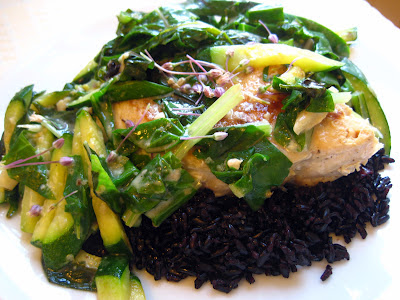Serve this over jasmine rice or jade pearl rice, with sauteed greens on the side.
 Ingredients
Ingredients12 oz wild salmon
Kosher salt
Freshly ground black pepper
2 tsp grated fresh ginger
1 small clove garlic, pressed
Mustard seeds
Onion blossoms
(or sub 1 scallion, thinly sliced)
Olive oil
1 cup chopped sorrel leaves
(about one third to half a bunch)
Sprinkle salmon generously with salt on both sides, and a little ground pepper on the non-skin side. Mash the garlic and ginger together, and then rub onto the fish (mostly on the non-skin side, and a little on the skin if you plan to eat it, which you should, because it will be amazing. Trust me). Sprinkle the non-skin side lightly with mustard seeds and the onion blossoms or scallion.
Heat a nonstick pan over medium heat. When the pan is hot, add a glug of olive oil and swirl to spread in the pan. Place the fish in the pan skin-side down, wait a moment, then shake to make sure it's not sticking.
Cook for several minutes, until the skin is golden-brown, then flip and cook for a minute until the fish has just a hint of gold to it (if it's a thick piece of salmon, you may have to cook it for a couple minutes on the non-skin side...or, keep it skin side down, and put a lid on the pan for a minute to help it cook through).
When the fish is medium-rare (still that darker shade of pink in the middle), serve onto a bed of rice. The trick is to catch it just before it's as cooked as you want it, since it will keep cooking a bit over the hot rice. The other trick is to eat it medium-rare, because medium-rare salmon is amazing.
Drizzle a little more olive oil in the pan, add the sorrel, sprinkle with a pinch of salt, and toss to coat. Turn off the heat. Saute the sorrel, stirring, for about 20-30 seconds till it just starts to change color from a vibrant green to a darker olive tone. Pour over the salmon, and serve immediately.
Serves 2.





















